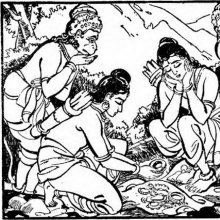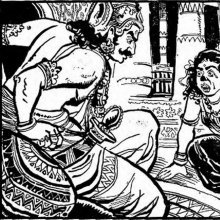Sitarama, Sītārāma: 3 definitions
Introduction:
Sitarama means something in Hinduism, Sanskrit. If you want to know the exact meaning, history, etymology or English translation of this term then check out the descriptions on this page. Add your comment or reference to a book if you want to contribute to this summary article.
Images (photo gallery)
In Hinduism
Chandas (prosody, study of Sanskrit metres)
Source: Shodhganga: a concise history of Sanskrit Chanda literature1) Sītārāma (सीताराम) is the father of Śambhurāma Miśra (18th century): disciple of Śrīnivāsa is credited with a metrical text named Chandomuktāvalī. Śambhurāma mentions one Hariguru in his invocatory verse, who probably was his preceptor. He was a Brahmin by caste and belonged to Kāśyapagotra. He was also a devotee of Lord Hayagrīva. He mentions about his gotra, name of his father in the end of the work and the name of his preceptor in colophon. He says with full of devotion that the work is dedicated to Lord Hayagrīva and the learned mass should relish the metrical testimony from it.
2) Sītārāma (सीताराम) is the disciple of Kandāḍa Veṅkaṭācārya (who resided in kuṭhārapura and who was also a devotee of Lord Viṣṇu) and the author of the Vṛttadarpaṇa. Sītārāma praises and mentions about his preceptor in the beginning of the work. He also gives his identity as he belongs to ātreyagotra and yajuśśākhā. Sītārāma starts work after praising goddess Lakṣmī in terms of Ramā in the invocatory verse of the work, composed in mallikā metre. As a well versed scholar of both Sanskrit and Drāviḍa languages, he says that on the advice of the learned scholars he has composed the works in both the languages.

Chandas (छन्दस्) refers to Sanskrit prosody and represents one of the six Vedangas (auxiliary disciplines belonging to the study of the Vedas). The science of prosody (chandas-shastra) focusses on the study of the poetic meters such as the commonly known twenty-six metres mentioned by Pingalas.
Languages of India and abroad
Sanskrit dictionary
Source: Cologne Digital Sanskrit Dictionaries: Aufrecht Catalogus Catalogorum1) Sītārāma (सीताराम) as mentioned in Aufrecht’s Catalogus Catalogorum:—father of Paramasukha (Ramalanavaratna). Bhk. 36.
2) Sītārāma (सीताराम):—one of the compilers of the Vivādārṇavabhaṅga. Peters. 2, 53. 187.
3) Sītārāma (सीताराम):—Āryāvijñapti kāvya.
4) Sītārāma (सीताराम):—Jānakīpariṇaya nāṭaka.
5) Sītārāma (सीताराम):—Vairāgyaratna. Sāhityabodha alaṃk.
6) Sītārāma (सीताराम):—Samayācāranirūpaṇa [tantric]
7) Sītārāma (सीताराम):—son of Lakṣmaṇa Bhaṭṭa, wrote in 1823: Kumārasambhavaṭīkā Saṃjīvanī (on 8-17).
Source: Cologne Digital Sanskrit Dictionaries: Monier-Williams Sanskrit-English Dictionary1) Sītārāma (सीताराम):—[=sītā-rāma] [from sītā > sī] m. Name of various authors and other persons, [Catalogue(s)]
2) [v.s. ...] [dual number] Sitā and Rāma, [Religious Thought and Life in India 184]
Sanskrit, also spelled संस्कृतम् (saṃskṛtam), is an ancient language of India commonly seen as the grandmother of the Indo-European language family (even English!). Closely allied with Prakrit and Pali, Sanskrit is more exhaustive in both grammar and terms and has the most extensive collection of literature in the world, greatly surpassing its sister-languages Greek and Latin.
See also (Relevant definitions)
Starts with: Sitarama paralikara, Sitarama shasrin, Sitarama shastrin, Sitarama suri, Sitaramacandra, Sitaramanujiya, Sitaramapaddhati, Sitaramaparalikara, Sitaramasamkirtana, Sitaramashastrin, Sitaramashrama, Sitaramashtaka, Sitaramashtottarashatanaman, Sitaramastotra, Sitaramasuri, Sitaramatattvaprakasha, Sitaramavihara, Sitaramaviharakavya, Sitaramayantroddhara.
Ends with: Ghositarama, Jaisitarama, Sataka-sitarama.
Full-text (+39): Shakanighantu, Rama, Sitaramasamkirtana, Sitaramavihara, Sitaramastotra, Sitaramapaddhati, Sitaramaviharakavya, Sitaramatattvaprakasha, Sitaramayantroddhara, Sitaramacandra, Sitaramashastrin, Sitaramaparalikara, Sitaramasuri, Chandomuktavali, Sitaramashtaka, Sitaramanujiya, Sitarama shasrin, Sitaramashtottarashatanaman, Citapati, Shambhurama.
Relevant text
Search found 32 books and stories containing Sitarama, Sītārāma, Sita-rama, Sītā-rāma; (plurals include: Sitaramas, Sītārāmas, ramas, rāmas). You can also click to the full overview containing English textual excerpts. Below are direct links for the most relevant articles:
Nitiprakasika (Critical Analysis) (by S. Anusha)
Life A Precious Gift of God < [October – December, 2000]
Thank God < [July – September, 2003]
Sri B. Sitarama Rao: An Appreciation < [July 1948]
Sanskrit sources of Kerala history (by Suma Parappattoli)
13. Balarama-vijaya by Sitarama < [Chapter 5 - Sanskrit Dramas and Campus bearing on Kerala History]
Chaitanya Bhagavata (by Bhumipati Dāsa)
Verse 1.11.44 < [Chapter 11 - Meeting with Śrī Īśvara Purī]
Verse 1.10.114 < [Chapter 10 - Marriage with Śrī Lakṣmīpriyā]
Verse 2.13.84 < [Chapter 13 - The Deliverance of Jagāi and Mādhāi]
Hanuman Nataka (critical study) (by Nurima Yeasmin)
Kena Upanishad with Shankara’s Commentary (by S. Sitarama Sastri)
Related products


